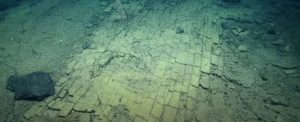Uncategorized
Scientists Follow a ‘Yellow Brick Road’ in a Never-Before-Seen Spot of The Pacific Ocean

After uncovering what looked to be a yellow brick road on top of an underwater mountain near Hawaii, a group of marine researchers discovered they were no longer in Kansas.
In a YouTube video of the finding, a scientist remarked, “The yellow brick road?”
Others stated the rocks reminded them of a different mythological world: “It’s the route to Atlantis,” one researcher said.
The golden boulders, separated by perfect 90-degree angles, form a small strip that appears to have been chiseled and organized by human hands.

However, the paved street was merely the natural product of old volcanic activity hundreds of feet below the water’s surface, according to the experts in an explanation accompanying the video.
“At the top of Nootka Seamount, the crew discovered a ‘dry lake bed’ formation, which has now been identified as a fractured flow of hyaloclastite rock (a volcanic rock generated in high-energy eruptions when numerous rock fragments fall to the seafloor),” the researchers stated.
According to the study, the impressively brick-like partitions between the rocks are most likely the coincidental outcome of heating and cooling forces from several volcanic eruptions over millions of years.
While piloting a remotely operated vehicle (ROV) around the Papahnaumokuakea Marine National Monument, a protected conservation area encompassing approximately 582,578 square miles (1,508,870 square kilometers) of the Pacific Ocean northwest of Hawaii, the researchers took a detour down this eerie undersea road.
The trip is part of the Ocean Exploration Trust’s Nautilus Exploration Program. Its goal is to examine the ancient seamounts at Liliuokalani Ridge, located on the monument’s western boundary.
One of the team’s primary objectives is to gather geological samples from the area’s seamounts, underwater mountains generated by volcanic activity, to understand their ages and origins better.

The researchers noted on the Nautilus website that learning this might lead to fresh insights into the genesis of the Hawaiian Islands.
The crew will also gather microbial samples to see what types of strange creatures have managed to live near the Pacific’s deep, underwater volcanoes.
“Our examination of this hitherto unexplored location is assisting scholars in getting a better understanding of life on and inside the rocky slopes of these deep, ancient seamounts,” the researchers noted.
Previous voyages aboard the Nautilus research vessel have unearthed a plethora of weird aquatic anomalies.
During a trip to the Papahnaumokuakea Marine National Monument in 2018, researchers were taken aback by a wiggling, googly-eyed creature changing shape in front of the camera.
The species was eventually recognized as a gulper eel (Eurypharynx pelecanoides), a gigantic-mouthed fish that can unhinge its enormous jaw to consume anything more significant than itself.
During that voyage, the researchers in command of the ROV also made a cultural allusion in response to the unexpected scene in front of them.
“Looks like a Muppet,” commented one researcher.


